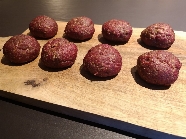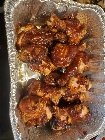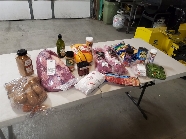- Joined
- Aug 3, 2020
- Messages
- 3,493
- Reaction score
- 3,785
- Points
- 113
- Location
- stl mo
- Grill
- Pro 575 Bronze► OKJoe's Longhorn Combo► WeberQ Gasser ►Weber kettle► UDS ► Inkbird Sous Vide
What is bark?
Bark is an incredibly tasty crust that forms on your smoked meat. It is actually the result of some complex chemical reactions that have happened throughout the cooking process. Specifically, the Maillard reaction and polymerization.In basic terms, bark forms when the surface of the meat is exposed to heat and oxygen. When the meat is also exposed to smoke, the bark will become a dark, licorice color. Without exposure to smoke, the bark will be more of a dark red, mahogany color.
Interestingly, contrary to common belief, caramelized sugar is not responsible for the formation of the dark crust on the meat. Ideally, the optimum cooking temperature inside the cooker should be between 225 – 250°F. However, table sugar does not start to caramelize until it hits 300°F.
As the meat is cooking, the surface begins to dry out. Proteins on the meat’s surface bond together and form polymers. This is called the Maillard reaction. The result is a hard layer on the surface of the meat, called the pellicle. If you applied a spice rub to your meat, it will form a crust just on top of the pellicle.
And there you have it – in more common terms, the bark.
How does fat content affect the bark?
As is the case with the temperature, when it comes to the fat content of the meat, balance is required to form a great bark. It is not simply a case of the more fat, the better.Fat is necessary to form the bark, because the fat soluble components in the rub dissolve and hold on to the spices, forming the crust.
If your meat is too fatty, however, it could hinder the creation of the pellicle (a thin skin, cuticle, membrane, or film), by obstructing the access of heat and oxygen to the proteins on the surface of the meat.
In light of this, it is advisable to trim off any excess fat. Aim to leave just enough fat to render and provide that nice glossy glaze for the spices, smoke, and dissolved salt and sugar to stick to.
How does moisture affect the bark?
To form a bark, there must be some moisture present so that the water soluble ingredients can dissolve. The moisture that is naturally in the meat and the smoke is usually adequate.Therefore, you don’t need to go crazy basting of your meat throughout the cook. Too much moisture will in fact stop the bark from forming, because the surface of the meat needs to dry out in order for the Maillard reaction to start.
Tips & Tricks to guarantee a good bark
- Remove any excess fat from your meat. Around a ¼ inch to ⅛ inch of fat on your meat is all you will need.
- Don’t sit your meat in a pan while it’s on the smoker. This will reduce the airflow and prevent the surface from drying out. Sit it on the grill plate.
- Sugar can char and cause your bark to be bitter in taste. If you are a beginner, you could try applying sugar in the form of a baste during the latter stages of the cook.
- Some pitmasters use butcher paper through the stall, around the point when the temperature is 160oF, and report no ill effects. Others, however, swear that wrapping anything around your meat will kill your bark. The jury is out on this one – perhaps a little experimentation is in order.
- Don’t mop or spritz for the first 2 hours of the smoke. Not only are you potentially washing off your rub, you may also be hindering the formation of the crust. The crust will have started to form after a couple of hours. It is safe to baste, mop or spritz after this has happened.
- The Smoke: Smoke is the second most important factor in bark formation. The longer a piece of meat is exposed to smoke, the dark and heavier the bark will become. A piece that is aged for about 12 hours will appear almost burned. The meat is not burned, however, and if done correctly, this dark bark is highly coveted.







